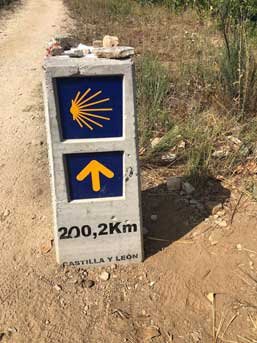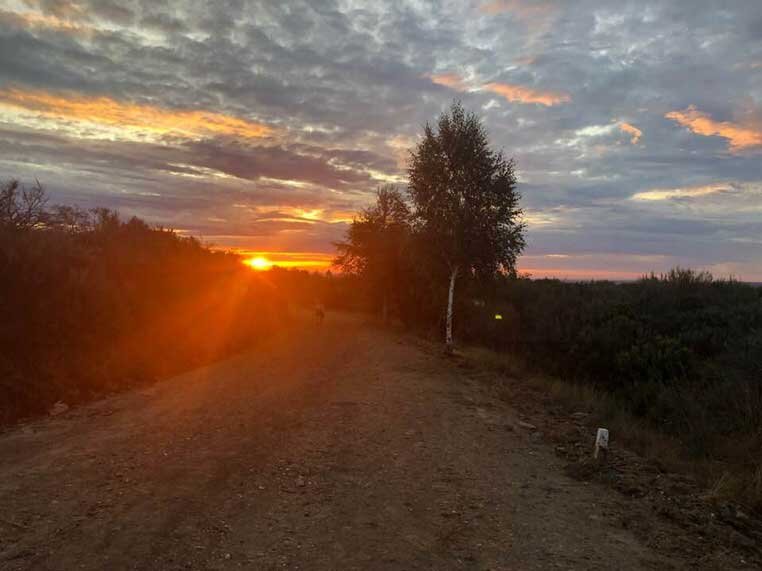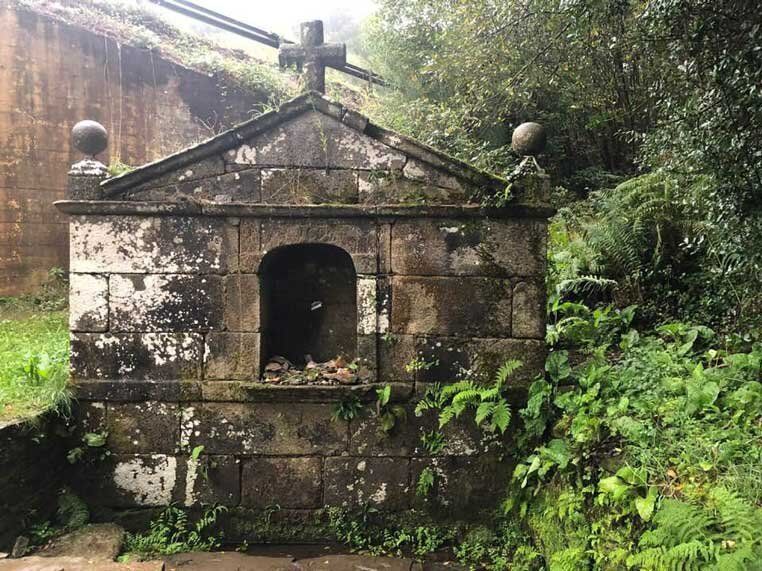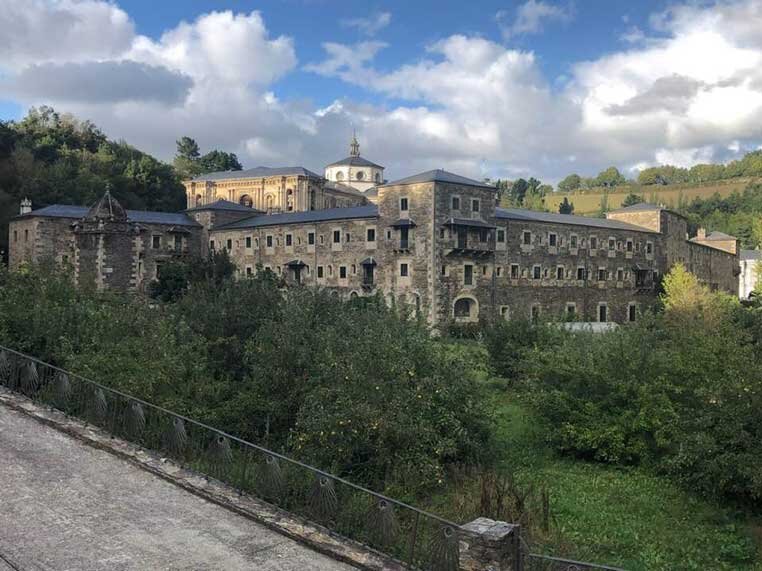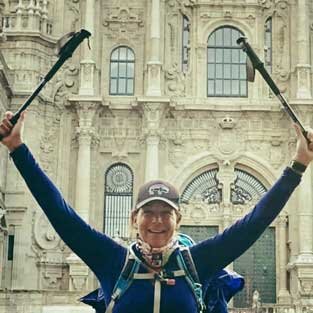The Journey of Un-Becoming

Walking Spain’s Camino de Santiago
story & photos by Stacey Soboleski
“Maybe the journey isn’t so much about becoming anything. Maybe it’s about un-becoming everything that isn’t really you, so you can be who you were meant to be in the first place.”
In September 2019, I had the incredible good fortune to walk the Camino de Santiago (The Way of St James) in Spain. It had been a dream of mine for a very long time, and I can honestly say that I am forever changed because of the experience.
The Camino de Santiago is an ancient pilgrimage route that has been traveled by Christians for more than 1,000 years. There is evidence that in pre-Christian times, the Celts traveled a route following the Milky Way. These ancient routes began to appear all over Europe, at a time when early faithful travelers used to begin their pilgrimage simply by walking out their front door. Today, tens of thousands of people from over 200 countries take part in this spiritual and deeply personal journey every year.
So why do people want to walk the Camino? Historically, Christians made the pilgrimage for religious purposes, seeking either atonement or penance. Today, many walk in search of the metaphorical pause button on their lives, to escape the hustle and busyness of everyday life and engage in deeper self-reflection. For others, the walk presents a physical challenge because of the daily 25-30 kilometers (15-18 miles) of walking and climbing. In one way or another, for every person who steps foot on the path, it becomes a spiritual journey, forcing them to unplug, slow down, and look deep within.
I learned about the Camino after watching the movie, The Way. For years after, I knew that it was something I simply had to do one day. The opportunity arose in 2019, when my husband and I were about to become empty-nesters. For the first time in more than twenty years of being a stay-at-home mom, I felt emotionally unsettled and asked myself, “What now?” I had a deep desire to move away from the familiar and do some much needed soul-searching. The Camino seemed like it could shed some light onto what the next chapter of my life could look like.
Each day on the Camino I would put on my backpack, which contained all of my belongings, and head out the door not knowing what I would see, who I would meet, or where I would sleep at the end of the day. A typical day on the Camino started with café con leche and either a croissant or toast at one of the local bars. Bars in Spain are more similar to a cafe or informal restaurant in the U.S., and that’s where I’d have lunch later in the day, perhaps a Tortilla de Patatas (Spanish omelette) or a Bocadillos (Spanish sandwich). Both of these options are quite filling and provided enough fuel to keep me moving.
As I didn’t want to add extra weight to my backpack, I didn’t carry a lot of extra food with me. There were stretches on the trail with no places to get food or water . . . especially on a Sunday. I tried to plan ahead by reading my guidebook and calculating how long it would take me to get to the next town, but sometimes I got it wrong. One of the most surreal moments I experienced on the Camino happened on my second day of hiking. I was experiencing the beginning stages of a large and painful blister forming on my right big toe as well as sharp pain in my left foot. I was only on day two, and I was worried—one of the biggest concerns of the pilgrims is that they will become so injured that they can not complete the Camino.
I had just struggled up a very long, steep, and rocky incline and was worrying about how I was going to make it to the next town for a place to sleep. My water supply was low, and I hadn’t eaten for hours. When I say it was in the middle of nowhere, I am not exaggerating. There in the distance at the top of the rocky incline, I saw what looked like a fruit stand next to some brick walls and awnings. I soon arrived at a pilgrims’ oasis called La Casa de los Dioses Cantina, home to a charismatic and hip guy from Barcelona named David. For over 10 years David has provided free food and drink, as well as a place to rest for weary hikers. His refuge offers plenty of shade, relaxing hammocks, benches, pillows, cookies, fresh fruits, and an assortment of beverages. There is a small donation box, but he doesn’t even mention it, and everyone who stops there is beyond grateful to contribute to his kindness and generosity.
Knowing the trek can inspire appetites, most local restaurants and albergues (hostels) offer a Pilgrim’s Menu for dinner. For around € 7-10, ($8–$12) you will get a three course meal plus bread and wine. The first course is either a pasta or salad, followed by the main dish (usually chicken), and finishing with a dessert. As I got closer to Santiago, the food choices changed to more Galician-style cuisine featuring plenty of seafood. A couple of the most famous dishes for this region are the tapas dishes Pulpo a la Gallego (Galician octopus) and Pimientos de Padrón (Padron Peppers).
A stay at the smaller albergues often includes a place at the table for a family-style dinner, typically prepared with the food from their gardens. The larger albergues have cooking facilities, which allow pilgrims to prepare their own meals either for themselves or as a group. My dinners with fellow pilgrims on the Camino were some of the best moments of my trip. After a long day of walking, an evening filled with laughter, singing, stories, and plenty of wine led to more than one life-long friendship.
Accommodations on the Camino ranged from a large 300-bed, barrack style albergue to a private room with a bathtub (bliss!) in a beautiful 1700s stone farmhouse. I slept in a converted thousand-year-old medieval pilgrims’ hospital, where I was awakened in the early morning by Gregorian chants. I stayed in a “Green” albergue which offered massages and vegan meals made with fresh vegetables out of their own garden. One of my favorite places to stay was Casa Susi. Casa Susi was a twelve-bed albergue in a converted barn owned by an Australian woman who had herself walked the Camino numerous times. Susi married a man she met while on the Camino and vowed to one day return and open a place of her own, offering all the creature comforts she had longed for while walking her own Camino. The evening I was there, I shared a family-style, delicious homemade meal with people from Latvia, South Africa, Hong Kong, Taiwan, the Netherlands, Australia, Spain, and the U.S.
My memories and experiences on the Camino will stay with me for a lifetime. I’ll remember my reverential climb to the Iron Cross (The Cruz de Farro), taking part in an ancient tradition of leaving the stones I’d brought from home that symbolized the burdens I wished to leave behind. There was the day I went seven miles off the beaten path on a solitary journey to visit a magnificent sixth century Benedictine monastery. There was the unforgettable kindness I was shown by strangers who would magically appear just when I needed them the most. One of my favorite memories has to be the sound from the lone bagpiper as I made my final approach through the stone archway to the Cathedral de Santiago. I had just completed my own 200-mile journey following in the same footsteps as the hundreds of thousands of pilgrims who had gone before me.
So did I figure out the next chapter of my life? Perhaps. I know that I changed after my experience on the Camino . . . and I can’t wait to do it again. Getting away and walking every day for almost a month changes the way you see yourself and gives you that rare gift of time to reflect on what is really important. The beauty and simplicity of slowly walking through Spain helped me remember who I once was. It helped me let go of who I wasn’t so that I could once again be who I was meant to be in the first place.
Stacey Soboleski lives in Philo with her family and menagerie of animals. She loves to travel, hike, and immerse herself in learning new ways to improve health through holistic health nutrition.

